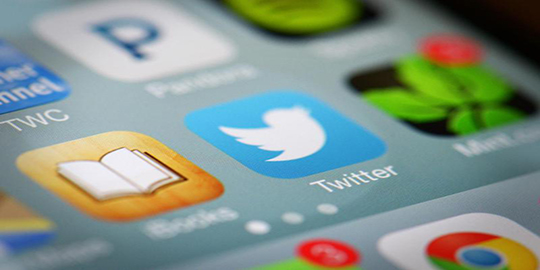
Technology Observatory October 13-19
In this week's technology observatory we bring you the following stories:
● Twitter introduces micro-transactions and payments between users in France
● Samsung promises Wi-Fi networks at 60Ghz and 575 MB/s in 2015
● Apple Pay to reach Europe in 2015 courtesy of Visa
● Samsung Galaxy Note 4 now on sale in Spain
● Google Express offers same-day deliveries like Amazon
● The next generation of batteries: charge in minutes, last decades
● Facebook chooses Samsung to make its upcoming cell phone
● New from Google
○ Nexus 6
○ Nexus 9
○ Google Nexus Player
○ Android 5.0, Lollipop
● New from Apple
○ iPad Air 2 and iPad mini 3 with Touch ID
○ New Mac mini
○ New iMac with Retina 5K display
○ The greatest Apple innovation unveiled today... the blank SIM card.
○ Plus, OS X Yosemite now available and iOS 8.1 available on October 20
Something was brewing at Twitter as regards mobile payments, and although we all still think it's a great idea for the service to act as a gateway for shopping on sites like Amazon, it seems the company also has plans to boost mobile payments through mobile micro-transactions, at least in France, where in partnership with a regional bank the social media site has just launched a user-to-user payment system. For now, the service is available to French users only, irrespective of the bank they use but based on the infrastructure launched by Groupe BPCE, the country's second largest bank in terms of volume. What is interesting about this development it that it's open to all users and not limited to just one bank, which means that any user in France who has a Twitter account can carry out micro-transactions regardless of the destination or issuer bank. "S-Money offers Twitter users in France a new way to send each other money, irrespective of their bank and without having to enter the recipient's bank details, with a simple tweet," said Nicolas Chatillon, chief execution of BPCE's mobile payments unit. At the moment, the service guarantees the security of communications at bank level, and the only thing Twitter does is put the two parties in contact with each other. It's clearly a very interesting system and we hope it will reach other countries as it not only removes the need for other money transfer applications but widens compatibility because the only requirement is having a Twitter account.
Manufacturers are becoming more and more inventive in their attempts to ensure that their future phones surpass their current ones on the market. Just when we thought we'd pushed out all the limits with GHz, pixel density and practically invisible display edges, here comes Samsung promising to deliver the fastest Wi-Fi connection ever. The Korean manufacturer has announced that it's working on wireless networking technologies that use the 60GHz band and can transfer up to 575 MB per second. This is astonishing when you think about the 108 MB currently available in 5GHz networks and the fact that this connection has always been quite precarious, but the use of high performance modems and transmit beamforming have enabled Samsung to achieve viable 60GHz transmissions. The manufacturer hopes to launch the technology at the beginning of 2015, so it looks like we won't have to wait too long to see these high-speed wireless networks in operation. Who knows? Perhaps Samsung will take the plunge and create a Galaxy S6 with this type of Wi-Fi.
At the presentation of the iPhone 6 and 6 Plus, and by extension the Apple mobile payment system, the company made it clear that the service would be limited to the United States, basically because of the agreements with the U.S. banking and retail sector, but now it seems that Europeans will soon be able to take advantage of the system as well because Visa is working with Apple to launch Pay in Europe at some point in 2015. Pedro Sousa, Head of Visa Contactless, has confirmed that although there is no precise date as yet for the service, Apple Pay will be compatible with its contactless system and will become available during the course of next year. Visa seems to have a particular interest in Apple Pay, which it believes could well be the solution to payments via NFC systems because it removes much of the friction experienced by users who utilize these types of payment systems in contact mode:
"Apple's entry to the market represents a critical piece of the mobile payments jigsaw. Not only does Apple Pay work as a tech, but also as a viable business space for companies," said Steve Perry, chief digital officer at Visa.
And it's not just Visa that has shown interest in the Apple system. The majority of payment and credit card companies view Pay as the solution to a problem that had remained thus far unsolvable: providing users with the tools to make payments from their cell phone as quickly and easily as with their credit card. For the moment though, despite the enormous interest shown by credit card companies, Apple Pay needs the support of local business to become more than just a token novelty, because achieving compatibility with the Apple system means changing most of the current credit card terminals in local businesses, especially the smaller ones, and this is clearly the most difficult task that banks and card companies are going to face. So while it certainly looks like a great way to make payments, the system is clearly still in its infancy, at least outside the United States.
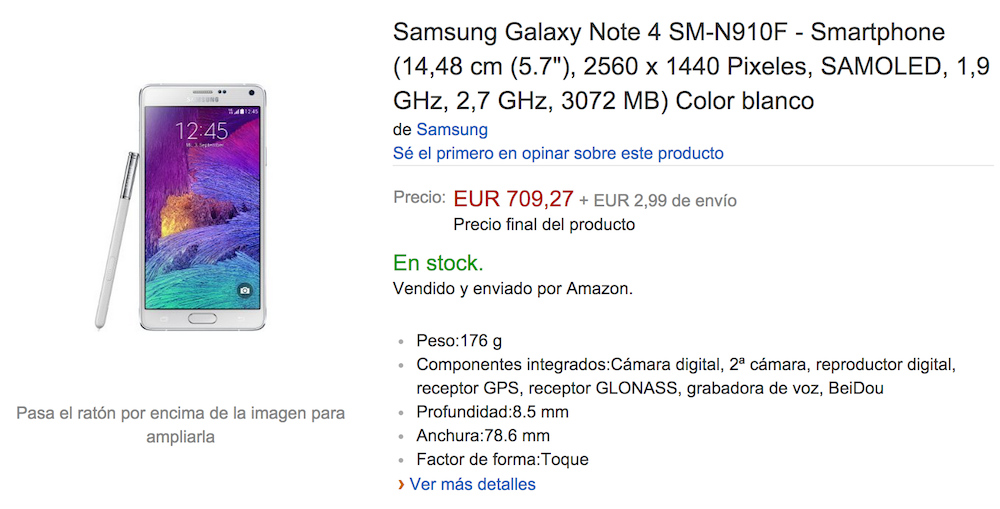
It was one of the devices that everyone had been waiting for and now it's here. The Samsung Galaxy Note 4 took center stage at IFA 2014 in Berlin, where the South Korean manufacturer unveiled it at a major event alongside its variant Edge (no sign of its arrival yet), the Gear S watch and the virtual reality headset Gear VR. We've already described everything there is to know about it – its specifications, design and all the new functions and software it comes with to make the most the enormous 5.7-inch display and S-Pen. If you were waiting for it to be released on the market to upgrade your smartphone, we can tell you that it's now available for purchase in Spain. Samsung took its time announcing the official price of €749, and it also gave October 24 as the release date. However, if you want to get hold of one right now, the 32GB version is already available at the well-known online store Amazon at the price of €739 if you want premium delivery by October 20. But it's also available at the much more interesting price of €709, and in principle around the same date. To refresh your mind, here again are the specifications for this new flagship and reference in the phablet segment:
● 5.7-inch AdobeRGB AMOLED display, 2560 x 1440 pixels, Gorilla Glass 3
● SoC Snapdragon 805 APQ8084 at 2.7GHz (SM-N910S) | Exynos 5433 (SM-N910C)
● Adreno 420 GPU | Mali T760
● LTE Cat 6 | Cat 4
● 3GB RAM
● 32GB internal memory
● 16MP camera with Smart OIS sensor, image stabilization, autofocus, flash LED
● 3.7MP front camera
● 3220mAh fast-charging battery
● 153.5 x 78.6 x 8.5mm, 176g
● Metallic finishes and textured back cover
● UV/temperature detector, heart rate monitor, finger scanner
● NFC, Wi-Fi, S-Pen, MHL, GPS, GLONASS, Wi-Fi Direct, DLNA, Wi-Fi hotspot
● Android 4.4.4 Kitkat with TouchWiz personalization layer
If you're looking for one of the best Androids of the year, you can now purchase it on Amazon, one of the most highly rated online service providers. Ok, the price is quite high, but some people can and are willing to pay it.
Google Shopping Express is a fast-delivery purchase service (buy online and receive your order the same day). A relatively new service from Google, it was first launched on a free trial basis in San Francisco and Silicon Valley in the spring of 2013. It went live in September of that same year, and in the spring of 2014 was extended to New York and Los Angeles. Today numerous changes were announced. Google wants to compete with Amazon in the purchase delivery market. Accordingly, the company has extended the scope of Google Shopping Express, adding more service areas, clarifying details about its membership program, offering new retail options for stores, and adopting a more agreeable and catchier name (Google Express). Until now, the Google Express service was only available in the aforementioned areas, but now residents of Boston, Chicago and Washington DC can take advantage of it. Google is keen to maximize the use of this new service and for customers to try it out for at least three months, either by signing up for one year at an annual cost of $95 or a monthly flat rate of $10. Alternatively, customers can opt to pay $4.99 per delivery. Sixteen new stores have been added, as well as prestigious brands like Barnes & Noble and Giant Food, and in the Bay Area customers can also purchase alcoholic drinks. Google doesn't want Amazon to take the entire cake and is clearly going to fight tooth and nail. Will Google Express reach other areas and countries, or is it doomed to become another failed experiment? At the moment Amazon already offers same-day delivery in Madrid.
Fast-charging batteries are great, but we also want them to last more than two years without a drastic loss of their capacity. Now it seems that the two are compatible and there's no need to sacrifice speed to longevity. Nanyang Technology University has developed a lithium-ion battery that can be recharged up to 70% in only two minutes and should have a lifespan of around 20 years, far in excess of the few months these batteries currently last. The new battery is not just ultra-fast-charging. It lasts a lot longer as well. The trick is that it uses titanium dioxide nanotubes for the anode instead of graphite. These increase the speed of the chemical reaction inside the battery and offer over 10,000 recharge cycles instead of the 500 you can expect from your smartphone battery. No date has been confirmed about when we might start seeing these breakthroughs implemented in the new smartphones, but titanium nanotubes are easy to make and relatively cheap. They could turn out to be a key solution to improving batteries, and removing the forced obsolescence of terminals. Not only that: in addition to cell phones, tablets and laptops, they could have a tremendous impact on electric cars, which would be able to recharge their battery in a matter of minutes instead of hours. And it would no longer be a case of having to replace the batteries before the whole car.
Facebook just won't give up – it wants its own phone. It seems they haven't learned from their earlier fiascos. But it doesn't matter as they've found an ally with many of the same interests. According to the Korean Herald, that ally is none other than Samsung. The South Korean giant wants to flee the Google ecosystem. And all to dive into Facebook's, but that doesn't seem to worry them. Following several meetings between senior Facebook and Samsung executives, the two companies have agreed to build a joint terminal. Hopefully, it will still be Android. Facebook has invested enormous resources in our operating system and Tizen doesn't seem to have Samsung's blessing, at least not in the field of smartphones. Zuckerberg's social media site is after the usual thing, i.e. reinforcing its position in the mobile world, while Samsung wants to improve its content business. The idea is that the two will share the same strategy to compete with a common rival called Google. Samsung recently shared a few projects with Facebook, as illustrated for example by the Gear VR. This particular Samsung terminal would have the Facebook Home launcher preinstalled as well as certain Samsung music services and access to the Galaxy Apps. Facebook knows that if it wants to carve out a niche for itself it will have to pull all the stops out, and as we've already said, no one better than Samsung to meet its needs. Two companies, two giants, but who are still not content with their leading position. The social media site has tried everything it can think of, as has Samsung with its check book. If this alliance materializes, Facebook will finally have the hardware support it needs to expand its apps, which in any case are already installed in millions of Android devices. Meanwhile, Samsung will finally have what will likely be a best-selling device with no tethers to the requirements imposed by Google. Let's hope they don't repeat the errors of the HTC First. We certainly support the alliance as it means more competition in the Android world. But what we'd really like to see is some innovation along the lines of Oculus and Gear VR, a gamble that goes beyond a simple launcher, a device with a difference, something like Amazon's FirePhone. That said, it is to be hoped that Facebook understands that if it wants to reach all Android pockets it can't accept its ally's pricing strategy. What do you make of this alliance? Do you think Facebook might finally manage to develop a viable phone? And is Facebook the ally that Samsung needs to escape Google?
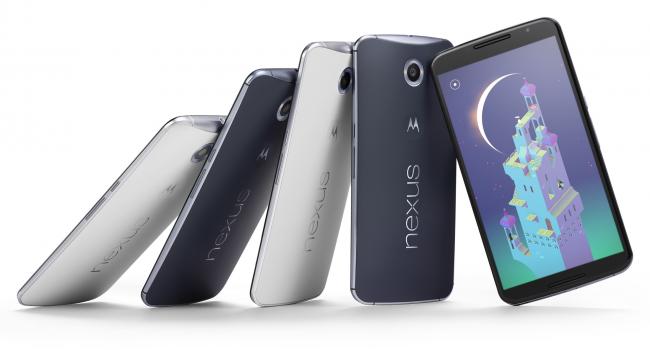
The rumors have finally been confirmed and Google has once again chosen a curious and discreet way of presenting its new range of Nexus products and Android L, which we now know will be called Lollipop. There's a new flagship smartphone from Mountain View that goes by the name of Nexus 6. The rumors about its specifications, the confirmation through CPU-Z, and the latest render from Evleaks have left very few unknown quantities to be clarified. Made by Motorola, it's a high-end terminal which in addition to offering powerful specifications looks set to become one of the best cell phones of the year. The Nexus 6 is a phablet through and through, as demonstrated by the dimensions: 82.98 x 159.26 x 10.06 mm, 184 grams. The design is reminiscent of the new Motorola Moto X, although adjusted to the longer lines and size of this terminal. It has an aluminum frame and a slightly curved back cover, making it easier to grip, although not everyone will be able to use it with one hand. Qualcomm Snapdragon 805 has been within the grasp of very few so far – for instance, the Note 4 – but now the Nexus 6 has joined this select club. Four cores at a connection speed of 2.7 GHz for impeccable performance and the 3GB RAM promise to become a benchmark pairing and offer an equally benchmark user experience. All of which is ideal for moving these new animations to 60 frames per second. The 5.96-inch display comes with WQHD resolution (2560 x 1440 pixels), a breakthrough we first saw in the LG G3 but which on closer inspection left us with certain doubts as regards its usefulness. The screen has AMOLED technology. Are so many pixels really necessary? It remains to be seen whether it's easier to appreciate them at this size.
Google and Motorola want to make up for the deficiencies of the earlier model and offer a full-fledged terminal in every aspect.
In terms of connectivity, the new device comes with 4G, Bluetooth 4.0 Low Energy, Wi-Fi and NFC. Nothing new in that respect. It will use a micro SIM card and this time it seems that both Google and Motorola have forgotten to add a micro SD slot to increase the terminal's internal memory. Supporting this hardware combination is a 3220 mAh battery, which in principle should guarantee a full day's autonomy. As you may remember, this was one of the main deficiencies of the Nexus 5, whose 2300 mAh were a little tight. It remains to be seen whether the camera sensor and processing software will be of a better quality. On paper, 13 megapixels and an f/2.0 aperture don't tell you very much, and then you have to remember that the cell phone maker is Motorola, which doesn't have the best photographic reputation in the sector. As to be expected from a member of the Nexus family, the latest device comes with a new version of the Android operating system, in this case Android 5.0 Lollipop: upgraded interface with Material Design, support for 64-bit processors, better battery management, etc. The changes with regard to Kitkat are quite significant but nonetheless in line with the transformation that Google began with version 4.4: a simpler appearance, more transparencies and a clean interface to prioritize information and maximize the use of gestures over the display to call or hide the different menus. Nexus 6 will be available at the end of this month. The date chosen is October 29, but for the moment we have no idea when the first units will arrive. What we do know is the price: €649 for the 32GB model and €699 for the 64GB. Having seen how the Nexus 4 and 5 sold, we were expecting a very competitive price for this new terminal from the Google family, but it seems things have changed because it's quite expensive, sitting firmly within the price bracket of high-end cell phones. This undoubtedly destroys the concept of the Nexus as a competitively priced phone. True, the release price is on a par with other flagships and its hardware is more innovative, but when people compare the more affordable prices of the last couple of years for the Nexus family they might think twice about buying this latest version.
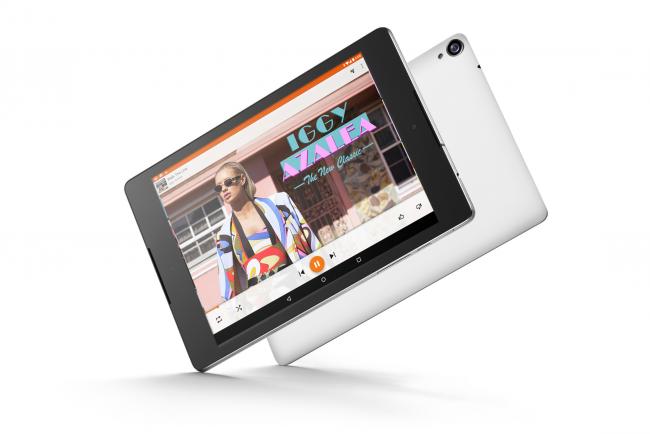
The Nexus 6 wasn't the only thing Google unveiled. It was accompanied by a new tablet with what we think a more appropriate size now that phablets are getting very close to seven inches. The Nexus 9 comes with an 8.9-inch, 4:3 format display with a resolution of 2048x1536 pixels and will reach the market with Android 5.0. Google's "return" to the large tablet sector was practically its only option. With phablets gaining ground on smaller formats like the Nexus 7, the only one they upgraded last year, it was high time for the new Nexus 9. But of course the competition in Android with the Z3 Tablet and Tab S from Samsung meant that Google had to offer a terminal which, despite the size of its display, had the same appeal as the Nexus 7: ease of use. With its 8.9-inch screen, the Nexus 9 weighs in at only 425 grams (436 grams in the case of the LTE version) and is less than 8 mm thick. As for its dimensions, it's 228 mm long and 153 mm wide, so in theory it should be easy to hold in one hand. Going back to the display, the format is 4:3 and the resolution 2048 x 1536. The protection is Gorilla Glass 3 and IPS is the screen technology. HTC, which as rumored was responsible for the Nexus 9, has chosen a dual core 64-bit Nvidia Tegra K1 processor for this tablet. This is accompanied by 2GB RAM and 16GB and 32GB of non-extendable internal memory provided by micro SD cards. The Nexus 9 battery is 6700 mAh, in principle in line with the specifications, but given the resolution and screen type we'll have to see the true capacity offered. As for connectivity, the Nexus 9 model comes with Wi-Fi ac, Bluetooth 4.0, NFC, micro USB 2.0 and support for Chromecast. The camera in the new Google tablet has an 8MP rear sensor, BSI, f/2.4 aperture and capacity to record video at 1080p. The secondary or front-facing camera is 1.6MP with a recording capacity of 720p. As regards the sound, the device comes with HTC Soundboom technology, which is good news for anyone who wants to maximize the multimedia aspect of the tablet. Made by HTC, the Nexus 9 will be available from the Google store from October 17. It will reach Spain on November 3 with three color options and two capacities: 16GB and 32GB. Only the 32GB model supports LTE connectivity. The prices are €399, €489 and €569 for the 16GB, 32GB and 32GB (LTE), respectively.
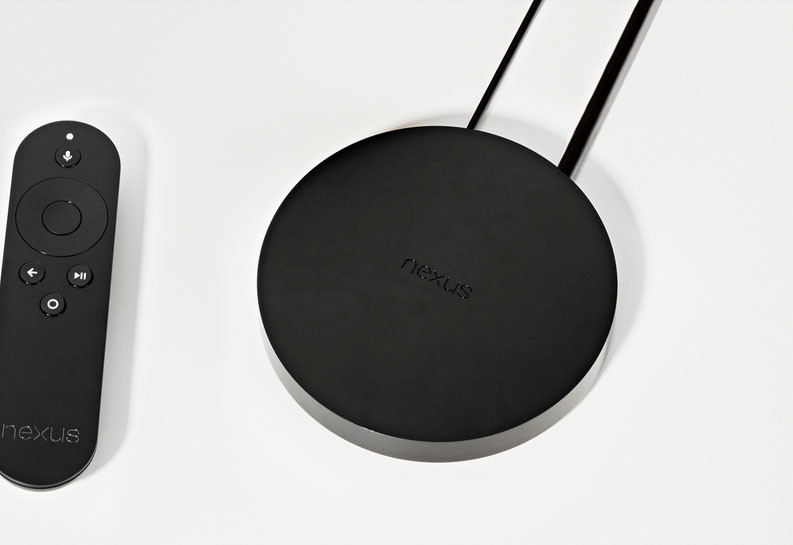
Google Nexus Player is now official. Today the search engine company unveiled the device that probably everyone was waiting for. The most apt definition would be a set-top console with Android, something along the lines of Ouya but with the Google signature on the back. In any case, it represents a new attempt by Google to enhance its Android services designed for home entertainment, after the ill-fated Nexus Q disappeared never to be heard of again. In terms of its shape, the new Google Nexus Player is distinctly reminiscent of that spherical contraption, though in fact it is actually a microcomputer with Android, though closer to a video console + multimedia player than a traditional PC. Google describes the Nexus Player as "entertainment tailored for you". The operating system is Android TV and it can be connected to a remote and gamepad. The former will be included in the package while the latter will be sold separately. In fact, the remote included is perhaps the most interesting thing as it features a microphone for giving spoken commands. It's a simple remote but sufficient for navigating the system menus, which are designed to be as trivial as possible. We're assuming that Google will also create a specific app for controlling the Nexus Player from a smartphone, although for now they haven't made any announcements. The gamepad is made by ASUS and appears to have no other novelties beyond offering two joysticks, a four-directional pad and buttons. Possibly a must for the Android game catalog, it certainly competes directly with Ouya and similar consoles. As for the technical specifications, very few details are available. We do know that it has a 1.8GHz quad-core Intel Atom Silvermont processor, but for more details we'll have to wait for the first analyses of the device. We're all familiar with Google Play apps and in all probability we've even be customers at one time or another. However, the rental and purchase of series, movies and music are lesser-known aspects and it's precisely this area that Google wants to revitalize with its new Nexus Player and, above all, with Android TV. The system is designed to be as trivial as possible while offering a very simple shortcut to Google's content catalog. Let's see what happens on that front. Another important aspect to bear in mind is what will happen with Chromecast, the tiny media streaming device that has worked so well – possibly due to the very affordable price of €35 at Amazon Spain – but which could now fall out of favor, especially since its functions are much more limited than those of the Nexus Player. Google has confirmed that the Nexus Player will be released on October 17, though we understand that it will only be available in the United States for now. The price across the pond is $99, so it will probably retail at €99 in Europe.
In the end, neither Lime Pie nor Licorice. The name of the new Android version will be Lollipop and it will be 5.0, marking a departure from the 4 that gave rise to three major upgrades: Ice Cream Sandwich, Jelly Bean and Kitkat. The mystery has been resolved and we now know all the novelties it will bring, though we did get a preview at Android L after Google I/O. The unveiling was quite discreet, and although we found out about most of the novelties at the last Google event there were still a few important details to be clarified. It's an ambitious upgrade that addresses major challenges: unifying the user experience, simplifying the interface, and looking ahead to the next devices and hardware that will arrive in the coming months. Material Design was presented as the cornerstone of Lollipop and reaffirms Google's commitment to simplifying its operating system and prioritizing content over menu elements. Flatter and with fewer ripples, its layer distribution lets you view the things you want to view, irrespective of your display. As an example of this adaptation, Google has shown us what applications will look like in each type of gadget. On tablets you'll get expanded information and the menus will be visible, while on cell phones the content will be prioritized and the other panels will only pop up when you slide your fingers over the horizontal edges. Finally, it comes with Android Wear, which has already demonstrated its raison d'être: showing excerpts of the most relevant information and performing certain actions from a smartwatch. It's not a vertical integration like that of Windows 10, but it's a determined effort by Google to unify the user experience on all its devices. Now this collection of displays is joined by Android TV. Google Nexus Player will be the main driver for this category through which Google wants to try and reconnect to our televisions. We told you about this at the Google I/O presentation and now we know that in addition to offering a multimedia center it also wants to take advantage of the Google Play gaming ecosystem and, courtesy of a remote, become a console. Thanks to this attempt to connect devices, you'll be able to share content between one device and another and (for example) start watching a video on a tablet and then pick it up from where you left off on a cell phone. Google hasn't yet specified how this system will work. The notifications will also be redesigned to merge with the index format and will have greater visibility on the notification screen or the floating windows that will pop up when you're using other applications. The energy controls have also been overhauled to make them more accessible and you'll be able to take a short cut to the ones you use most often by double swiping the top margin. Google Now will be more integrated with your devices and the "OK Google" option will stay on when the display closes down, as in the original Motorola Moto X. It remains to be seen whether it will be a launcher option in the Nexus 6 and 9 (it will only work in those models for now) or whether it will be extended to other devices. As regards tablets, some time ago we saw how Google introduced a mode for different users. Now this option will also be available in smartphones and you'll be able to create several profiles or a guest mode. In both cases, you'll be able to choose which applications can be opened. This new version signals two major changes in the hardware. For one thing, it's the first version that will support 64-bit processors. The Nexus 9 will be the first to use Android Lollipop 5.0 and this technology, though we'll have to wait until next year to see whether this chip is extended to other models. The other great upgrade has to do with the virtual machinery. Finally, Google has ousted Dalvik as an option in the Android settings menu. Now we'll have ART (Android Runtime), though it remains to be seen whether the transition will have been worth it, not only for developers and manufacturers but end users as well. Project Volta is another key name associated with Android Lollipop. Google promises that this system will improve battery software management. Added to all this are the energy-saving modes, a feature that several mobile device manufacturers have already implemented in the software layer but which Google has only now taken up. Nexus 6 and 9 will come with Android Lollipop by default but users of Nexus 4, 5, 7 and 10 will have to wait a few weeks. The next candidates to be upgraded will be the Motorola terminals, which up to now have demonstrated the greatest loyalty. The other mobile devices will move up to Android Lollipop 5.0 as and when manufacturers deliver this new upgrade. That could take weeks or months, or might not materialize at all.
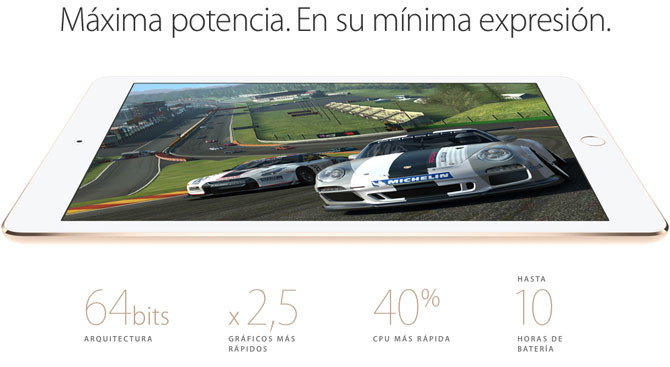
No surprises where Apple is concerned. As expected, the company unveiled the new iPad Air 2, a slimmer and more powerful device with a Touch ID sensor. But let's slow down. When we say slim, what we really mean is that at just 6.1 mm, the iPad Air 2 is not only 18% thinner than its predecessor but is also the slimmest tablet in the world. Continuing with this model, Apple has pulled out all the stops to ensure that in less than five years we have a tablet that is so light (it weighs in at just 437 grams) and thin that even when you place one on top of another it's still the slimmest device around. But above and beyond taking this bikini challenge to the extreme, the other benefits translate, paradoxically, into an even better display with fewer reflections that eliminates the very last portion of air between the glass and the image. Moving on to the processor, it has an A8X chip and second-generation 64-bit architecture that is 40% more powerful than the previous model. Furthermore, the GPU is 2.5 times faster, and yet they've still managed to guarantee 10 hours of autonomy. And, hey, shall we take bets on it having 2GB RAM? We'll have to wait and see about that because all we know for sure at the moment is that it boasts all the novelties introduced with the iPhone 6, including the M8 coprocessor and constant calibration of the sensors and barometer. The camera is another feature that's been greatly enhanced. The iSight camera on the back now has 8 megapixels and finally incorporates iPhone camera features like burst mode, slow-mo video and dual microphones for better sound quality. Meanwhile, the FaceTime HD camera has a completely new sensor capable of capturing 81% more light and an f/2.2 aperture. Next important point: connectivity. The iPad Air 2 comes with 802.11ac Wi-Fi, is 2.8 times faster with a connection speed of up to 866 Mbps, and in the case of the 4G LTE version is supported by 20 bands, which probably makes it the most international tablet that money can buy. Money, incidentally, which is distributed between three capacities that recall those of the iPhone 6: 12GB, 64GB and 128GB for €489, €589 and €689 in the case of the Wi-Fi version and €609, €709 and €809 for the Wi-Fi + 4G LTE version.
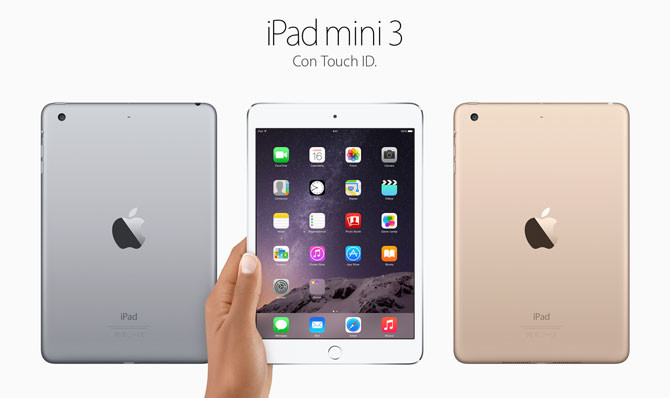
Unveiled with considerably less of a fanfare than its big brother, for obvious reasons, the iPad mini 3 has undergone a timid upgrade and now comes with the aforementioned Touch ID sensor but the same dimensions and weight, and even the same processor (A7), camera (5 megapixels) and connectivity (802.11n). The only notable novelty is the gold finish option. Perhaps the most important aspect of the iPad mini 3 launch is not so much the model in itself but how it affects Apple's tablet range, pushing its entry price up to €239 for the iPad mini and €289 for the iPad mini 2, both 16GB. Available in three colors and capacities, now standard for all of Apple's mobile devices, the iPad mini 3 retails at €389, €489 and €589 for the 16GB, 64GB and 128GB Wi-Fi models, and €509, €609 and €709 for the Wi-Fi + 4G LTE models. In Spain, both the iPad Air 2 and the iPad mini 3 can be pre-ordered online as from tomorrow, October 17, and will reach stores as early as next week.
The last time the Mac mini was upgraded was in 2012, when along with the Server version it received a few minor updates, so two years down the road it was high time the affordable Mac option got some attention. In fact, the Mac mini upgrade has not only brought the device bang up to date but put it within the range of anyone looking to build their own experience, as all you need is a monitor, mouse and keyboard and you're ready to go. The new Mac Mini will have three main personalization options, which you can customize even more if you purchase it online from the Apple Store: a fourth-generation dual-core Intel Core i5 processor with speeds of 1.4GHz, 2.6GHz and 2.8GHz, all equipped with Turbo Boost to increase the speed to 3.3GHz, plus the option of a 3.0GHz Core i7 processor with Turbo Boost up to 3.5GHz. As for the internal memory, it has a 500GB hard drive at 5400 rpm, or a 1TB Fusion Drive with the option of 256GB, 512GB or 1TB of flash storage. The RAM memory options are 4GB, 8GB and up to 16GB in 1600MHz LPDDR3 format. In terms of graphics, you get HD Graphics 5000 or Iris Graphics, both from Intel, which means you can connect two monitors with a resolution of 2560 x 1600 pixels. The dimensions are exactly the same as those of the previous generation – 19.7 x 19.7 x 3.6 centimeters – and it weighs in at between 1.19 and 1.22 grams. As regards connections, there are two Thunderbolt 2 ports featuring 20-Gbps channels, four 5-Gbps USB 3 ports, a compatible HDMI port with Full HD resolution at 1080p, a slot for SDXC cards, a Gigabit Ethernet port, a port for audio input and headphones, naturally, and an infrared port for remote control, as well as 802.11 ac/a/g/n Wi-Fi and Bluetooth 4.0. Lastly, the Mac mini comes with the iWork office suite, iLife entertainment and the latest update of its operating system, OS X 10.10 Yosemite. The Mac mini is available now and ships within one to three business days. As mentioned already, there are three basic configurations, as follows:
● 1.4GHz dual-core Intel i5, 4GB RAM, 500GB hard drive and Intel HD 5000 graphics, starting at €499.
● 2.6GHz dual-core Intel i5, 8GB RAM, 1TB hard drive and Intel Iris graphics, for €699.
● 2.8GHz dual-core Intel i5, 8GB RAM, 1TB Fusion Drive Intel Iris graphics, for €999
No surprises with this announcement either: as we expected, the desktop Mac now has a Retina display. Enter the new iMac with Retina 5K display, a 27-inch screen with seven times as many pixels as a Full HD screen and 67% more pixels than a 4K display. The result is an avalanche of pixels (5210 x 2880) in a device just 5 millimeters thick. To further enhance its performance, the display has a graphics controller to produce the finest-quality images, and a new TFT screen to improve performance and reduce energy consumption by 30%. As for the technical specifications, it comes with 3.5GHz quad-core Intel Core i5 processors, including Radeon R9 M290X graphics, upgradeable to M295X in the case of the Core i7 model. You'll find the same Thunderbolt 2 ports and all the other connections you're used to. The price is one of the most surprising aspects, bearing in mind what a 4K display costs, because these iMacs with Retina 5K retail at €2,629 for the basic configuration (3.4GHz quad-core Core i5, 8GB RAM and 1TB of Fusion Drive storage). Available as from today, although it will be a matter of time before they officially appear on the Apple website.
The new iPads and Macs were the protagonists of Apple's keynote event, but amid the new devices, jokes and figures to boast about, the new tablets from Cupertino introduced a huge novelty that the vast majority of people have overlooked but that could well mark an interesting new departure. We're talking about the blank SIM card. Inside models with mobile connectivity, this SIM will allow users to access different data plans from different operators – American and British for now – simply by selecting an option from the iPad itself. And they'll be able to swap operators whenever they want. In fact, there's nothing new about Apple's virtual or blank SIM card. The main idea behind this type of initiative is to provide users with the opportunity to access different operators. Armed with one of these SIM cards, they can choose from the operators available in the initiative, and even swap between them without having to change cards, and that's the idea that Apple's new iPads have captured. The new models with 4G connectivity will come with this virtual or physical SIM card (a lot of the details remain to be confirmed) and users who purchase them will therefore be able to take out plans with three U.S. operators (AT&T, T-Mobile and Sprint) and one British one (Everything Everywhere). This means that in the USA operators will have to compete with one another, given how easy it will be for users to choose which company they want as their data provider, whereas if you travel with a new iPad to the UK you'll be able to take out a local plan with EE. This means total freedom for users as they'll be able to buy a plan from one operator and then switch to another company, according to whichever is more convenient at any given time. Undoubtedly, this new option opens up a very interesting new avenue. We are sure to see more operators joining the Apple initiative and providing iPad users with yet more options, but most interesting of all is that other device manufacturers are likely to follow suit and introduce blank SIM cards in their own terminals, be they tablets or – better still – smartphones. The strangest thing about all of this is that the option wasn't included in the iPhone 6 released only a few weeks ago.
Plus:
